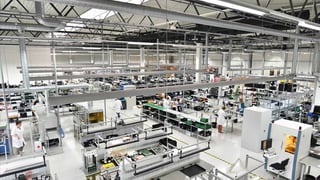Every year, the industrial sector grapples with unplanned downtime that results in $50 billion in lost productivity and goods sold.
This has prompted the transition to Industry 4.0 as they seek to mitigate or prevent disruption with Predictive Maintenance (PdM) and smart factory technology like Industrial Internet of Things (IIoT), which research has shown to be better at maximizing uptime than the run-to-fail maintenance model.
But how is this relevant at a smaller scale for mission-critical environments 100k square feet and under?
It’s all relative. Sure, in absolute terms, the capital impact of disruption in a 100k square foot plant versus a 2,000,000 square foot complex is not comparable.
But let’s say you’ve got a 5 million dollar capital infrastructure supporting a manufacturer. If those lines go down, the financial losses are every bit as impactful (in relative terms) for that guy as they would be for a large industrial complex with mega-million dollar built-up infrastructure.
Even for a small-mid sized mission-critical facility, the incentives to go to the nth degree to maximize uptime are still conceivably worth hundreds of thousands or even millions of dollars over a multi-year period. From manufacturing to Bio Pharma, medical, and food processing, there are myriad facilities where continuous HVAC operation is critical to operations.
PropTech companies (like nClarity) have been able to leverage the massive scale and investment in the industrial sector and distill the technology down into something extremely affordable that can drive similar results at a smaller scale.
The operations teams and service contractors who get smart and understand how this technology can be used to cater to the needs of their mission-critical clients are going to start picking off the best opportunities.
Get Cutting-Edge Mechanical Service Insights In Your Inbox
How IoT Predictive Monitoring Prevents HVAC Disruption
Packaged HVAC systems are an integral part of most mission critical facilities. Disruption to the continuity of cooling, heating, ventilation and refrigeration may impede production and/or delivery of critical services, resulting in not potentially costly repairs but also revenue loss from reduced productivity.
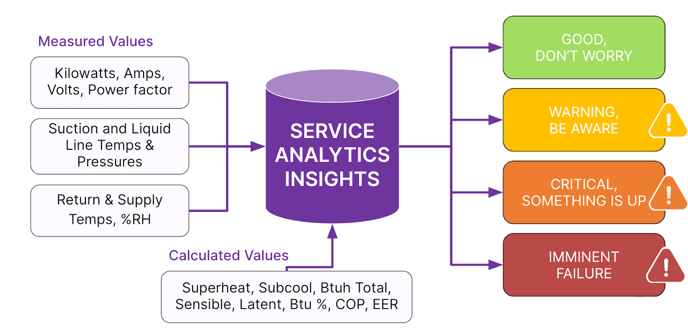
The nClarity system is monitoring the critical systems of a packaged unit every minute, 24/7. The data is fed into analytics, where machine learning algorithms generate insights and assign a color code based on severity.
IoT Predictive HVAC monitoring technology (like nClarity) leverages real-time performance data, tech-friendly analytics, and automated virtual equipment inspections to provide an early warning system to operations teams when a developing issue is identified that could lead to disruption. One of the most common sources of disruption is condenser fan motor failure. The different stages of degradation (yellow, orange, and red) include:
- Erratic Fan Motor Amp Readings (Yellow): A clear sign of condenser fan motor failure that will lead to higher liquid pressures
- High Liquid Pressure (Orange): Failing condenser fan motors are not properly cooling refrigerant, putting increased stress on the compressor.
- Condenser Fan Motor Failure (Red): This will usually cause the compressor to lock out and the space will not be conditioned until the fan motor is fixed.
Let’s look at how each of these three issues can be identified by the nClarity platform.
Yellow Alert: Erratic Fan Motor Amp Readings
A clear sign of a failing condenser fan motor is erratic amp readings. When the fan motor starts to fail and stops pulling heat off of the refrigerant lines, the compressor pulls more power under increased pressure, causing a higher utility bill and significant wear and tear on the compressor.
Here we can clearly see in the nClarity dashboard that the fan motor amperage is spiking to 60, an indication that it’s on it’s last leg:
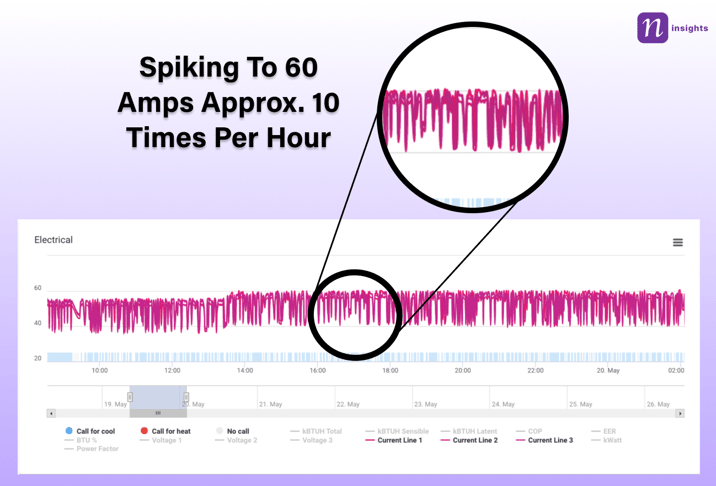
This data would automatically trigger an alert for the service operations team with nClarity’s Intelligent Insights, so they can diagnose and monitor the issue to determine the best course of action and avoid disruption.
Orange Alert: High Liquid Pressure
As the condenser fan begins to fail, it does not remove heat from the refrigerant as designed, causing the pressure on both the liquid and suction side to rise. High pressure will cause the compressor to work harder and fail in due time.
Here we can see that the liquid pressures are spiking to 400-500 PSI:
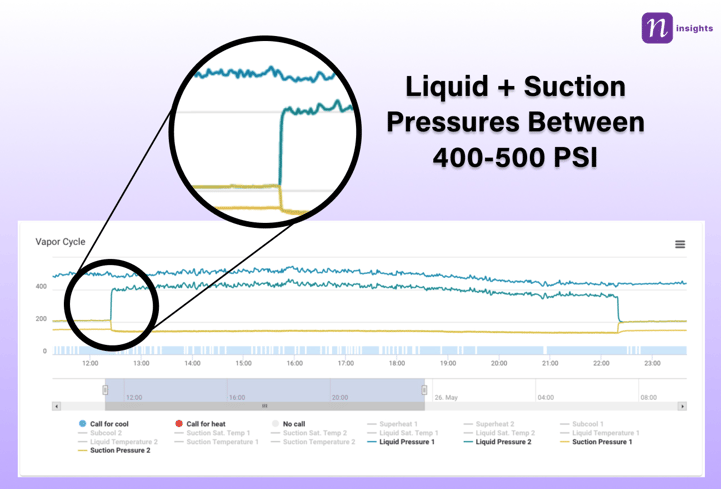
This is a clear sign that the condenser fan is not doing it’s job and putting stress on the compressor. Using nClarity’s trended data, a service technician can determine WHEN exactly the issue started and determine the level of urgency - something that is simply not possible when gauging up on site.
Red Alert: Condenser Fan Motor Failure
When the condenser fan motor has flatlined, the compressor will most likely lock out from extreme pressures. The space will not be conditioned until the condenser fan motor issue is resolved.
Here we can the fan motor amperage go to zero (while simultaneously observing the air side and vapor cycle):
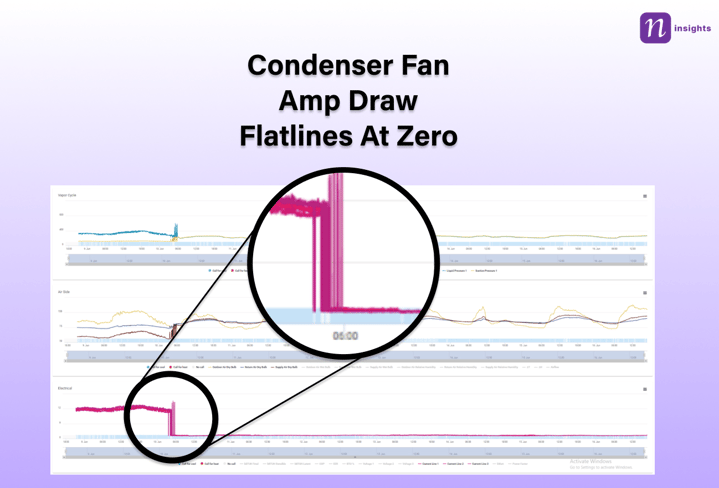
In a mission-critical space, this would be cause for immediate reactive dispatch to mitigate operational impact from no air conditioning.
The occurrence of motor failures like this, however, will be drastically reduced or completely eliminated with Predictive IoT HVAC monitoring thanks to early warnings that alert service teams to signs of degradation.
Despite Operations Teams’ best efforts, the current Preventative HVAC Maintenance model is unfortunately not 100% preventative. Until recently (with IoT tools becoming more accessible), even the most capable and thorough service technicians have not been able to thoroughly check the critical systems of each RTU with their limited time on the roof. Early stage issues like spiking fan motor amperage, leaking refrigerant, and other degradation can still potentially be missed, leading to disruptive failures.
If production and/or delivery of critical services gets disrupted, what might that cost you in potentially lost revenue? With cost-effective and easy-to-implement IoT technology like nClarity that provides you early (yellow) warnings like the above examples, the potential ROI is significant.
So, whether you have your own service technicians or rely on Mechanical Service contractors, there are systems available to give Facility Managers peace of mind that production won’t be disrupted.
Bring Your HVAC Online In One Day With IoT

In summary, integrating IoT Predictive HVAC Monitoring into your HVAC asset and maintenance strategy is the most powerful and cost-effective way to maximize uptime and prevent operational disruption in mission-critical environments.
The nClarity Predictive Maintenance Platform has been designed from the ground up with these needs in mind. Its IoT-based tech makes it cost-effective and quick to implement, and a small to mid-sized building can be brought online in as little as one day.
If you want to learn more about how nClarity can help you reduce operating costs and prevent operational disruption, click here.
